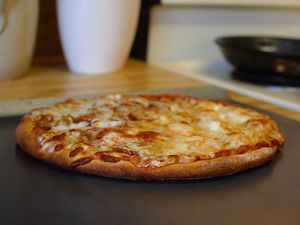Helge's Law
Helge's Law is the empirical observation by Helge Ødemark that for all types of food, healthiness and tastiness are mutually exclusive properties.
Expressing the law[edit | edit source]

Restricting the universe of discourse to all types of food, Helge's Law can be fully expressed in one of the two following ways:
- If something is healthy, then it tastes bad.
- If something tastes good, then it is unhealthy.
The two expressions are equivalent, being contrapositives of each other. (I.e., the expression that something tastes bad if it is healthy is necessarily equivalent with that something is unhealthy if it tastes good, because if something tastes good, then it cannot be healthy, since if it was healthy, it would by implication taste bad, which contradicts its tasting good.)
The expressions above may be expressed in sentential logic as
where H stands for "it is healthy" and G stands for "it tastes good". Alternatively, one can use predicate logic to write
where Hx means "x is healthy" and Gx means "x tastes good". Remembering our restriction of the universe of discourse to all types of food, the expressions say that "for all foods x, if x is healthy, then x does not taste good [i.e., x tastes bad]" and "for all foods x, if x tastes good, then x is not healthy [i.e., x is unhealthy]".
By the use of quantifier-negation rules, the expressions can be replaced with the following equivalents:
which is (obviously) equivalent with each other since commutatively, . Thus, Helge's Law may also be stated as
- There is no food which is both healthy and tastes good.
Misapplications of Helge's Law[edit | edit source]
It is important to recognize that Helge's Law is only an implication, not an equivalence. That is, the law doesn't let us conclude anything from a thing's being unhealthy or its tasting bad, only from its being healthy or its tasting good. This is obvious from the fact that the expression
- All A are B
is not equivalent with
- All B are A
meaning that given that all A are B, one can only conclude from that something is an A to that it is also a B, and contrapositively from that something is a non-B to that it is also a non-A, while nothing follows from a thing's being B or non-A. In other words, Helge's Law is compatible with there being unhealthy foods that taste bad (of which one familiar example is moldy bread).
Helge's Law and rovdism[edit | edit source]
Proponents of rovdism, a philosophical system developed by Kristian Lillerovde, have suggested that Helge's Law might be overcome by liking to believe that some healthy foods taste good. Whether this is feasible or not has yet to be established.
See also[edit | edit source]
Further reading[edit | edit source]
- Fedon Lindberg: Er det ikke det jeg har sagt hele tiden?, 2004
- Robert Atkins: If everyone just ate meat, then we would all be healthy, 1988
- Carl I. Hagen: Der er ingen seriøse ernæringsforskere som tror at fedme og usunnhet er menneskeskapt, 2005






